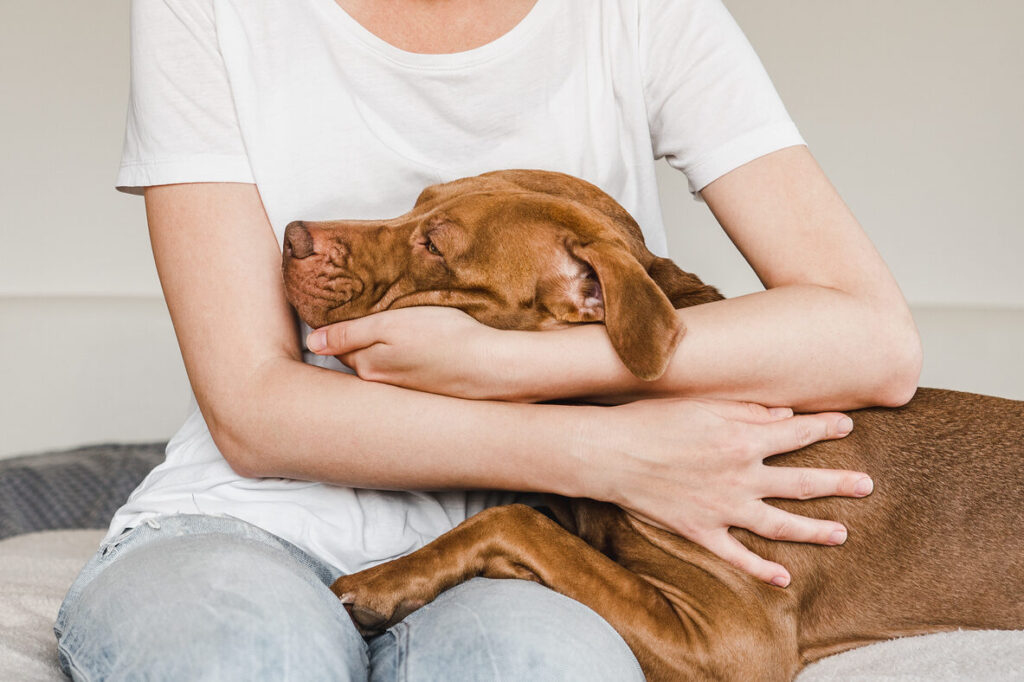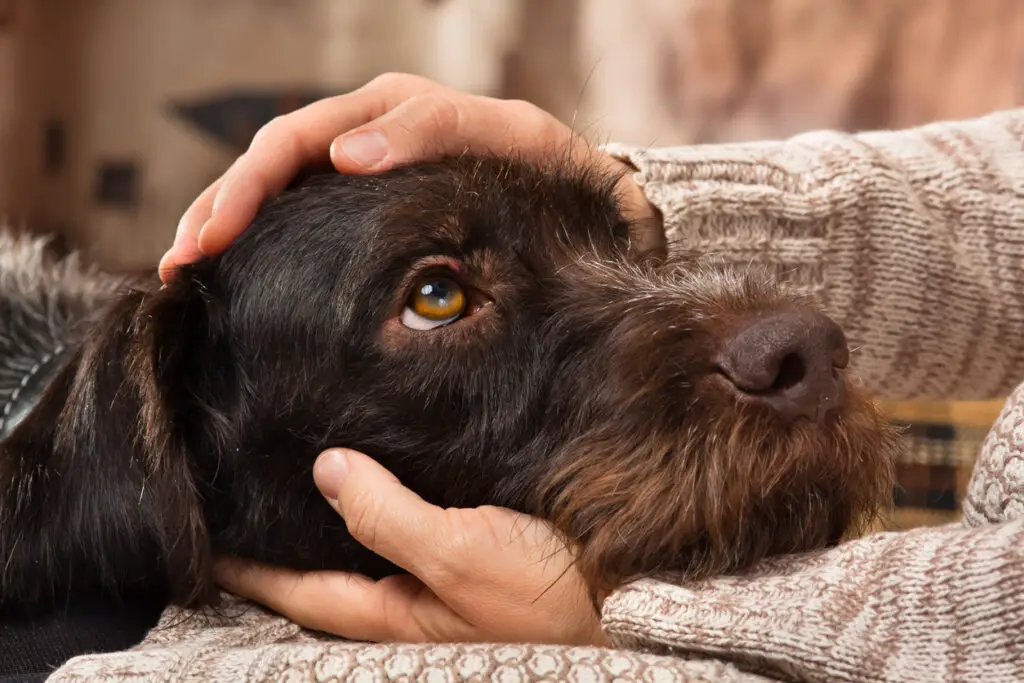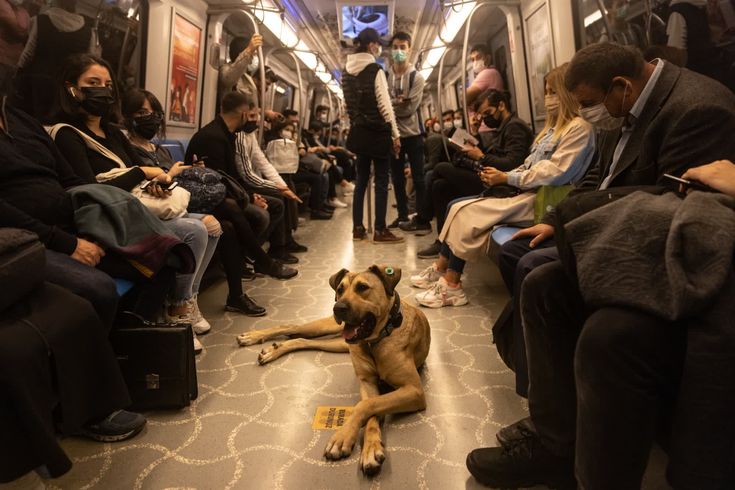1. Vacuum Cleaners and Hair Dryers

You might just be cleaning up or getting ready for the day, but for your dog, it can feel like a sudden thunderstorm indoors. Vacuum cleaners and hair dryers produce loud, high-pitched sounds that can trigger a dog’s stress response. Sensitive breeds especially react to the pitch and intensity of these noises. Dogs may run away, bark, or even tremble when these machines are on. According to the American Kennel Club, these devices can make dogs feel threatened. If your dog hides when you pull out the vacuum, it’s not just a cute quirk. Try creating distance or using quieter tools to help reduce their stress during these moments.
2. Hugging Too Tightly

When we’re feeling affectionate, it’s natural to want to wrap our dogs in a big hug. But for most dogs, being tightly held isn’t comforting. It can feel like restraint. Many dogs instinctively react to that kind of pressure with discomfort or anxiety. You might notice them turning their head, licking their lips, or trying to wriggle away. Canine behaviorist Dr. Patricia McConnell explains that dogs don’t interpret hugs the same way humans do. Instead of squeezing, show your love with gentle pets or ear rubs. Learn how your dog prefers to be touched, and you’ll see them relax. Your affection will feel more like a treat than a trap.
3. Scented Candles and Cleaning Products

That fresh citrus candle or deep-cleaning spray might smell like a clean home to you, but to your dog, it can feel overwhelming. With a nose far more sensitive than ours, dogs pick up scents intensely. Many popular products contain strong fragrances and chemicals that can irritate their senses. The Humane Society warns that certain essential oils and sprays can even be toxic or cause respiratory stress. If your dog starts sneezing, scratching, or leaving the room, it may be their way of asking for relief. Try using fragrance-free or pet-safe alternatives. Keeping your dog’s nose comfortable can help keep their mood balanced and your home a calm, safe space.
4. Inconsistent Routines

Life can get busy and unpredictable, but dogs really thrive when their day-to-day schedule stays steady. Dogs rely on routines to feel secure. If their walk time shifts constantly or their meals arrive at random hours, it can leave them feeling confused or anxious. Veterinary behaviorist Dr. Lisa Radosta says that predictability helps dogs know what to expect, which reduces stress. It doesn’t mean everything has to be perfectly timed, but some consistency with feeding, bathroom breaks, and bedtime goes a long way. You’ll likely notice that a routine-loving dog behaves more calmly and confidently when their daily rhythm is respected. Stability doesn’t just help people; dogs crave it too.
5. TV or Music Left On for ‘Comfort’

We often leave background noise like television or music on, thinking it’ll keep our dog company when we’re out. But not all dogs find this comforting. Sudden changes in volume, fast-talking characters, or high-pitched tones can actually startle or overstimulate them. Dr. Marty Becker, a veterinarian and pet wellness advocate, says dogs respond better to silence or calming, pet-specific sounds. If your dog seems unsettled or doesn’t sleep well when the noise is on, it may be too much. Instead of random shows or loud playlists, try quiet environments or curated pet relaxation tracks. What we think is soothing might not be what your dog needs most to feel at ease.
6. Petting the Top of the Head

Giving your dog a few pats on the head might seem normal to you, but many dogs don’t enjoy it. When a hand moves over their head, it can feel intimidating or even threatening, especially for shy or anxious pups. Trainer Victoria Stilwell notes that dogs typically prefer being petted under the chin, behind the ears, or along the shoulders. If your dog turns away or lowers their head when you reach over them, that’s their way of showing discomfort. Watch their body language to see what they truly enjoy. Meeting them where they’re most relaxed helps deepen your bond and makes every interaction feel safe and kind.
7. Mixed Signals About Rules

Sometimes we let our dog cuddle on the couch, and other times we tell them off for it. These mixed signals can really confuse dogs. They don’t understand occasional exceptions the way people do. One moment’s permission becomes an expected rule in their mind. The ASPCA warns that inconsistent rules can lead to anxiety and disobedience. It’s not that your dog is being stubborn; they’re unsure of what’s allowed. Choose a rule and stick with it. Make sure everyone in the household agrees too. When your dog knows what to expect, they become more confident and less reactive. Clear boundaries help your dog feel more secure and emotionally balanced.
8. Raised Voices or Arguing

You might not be yelling at your dog, but raised voices during arguments or even loud phone calls can still make them anxious. Dogs are incredibly sensitive to tone and emotional energy. Dr. Marc Bekoff, an expert in animal behavior, says dogs absorb stress from their environment, even if they don’t understand the words. If there’s tension, your dog might hide, shake, or act out. While we all get upset sometimes, keeping a calm voice around your dog can help them feel more secure. If things get loud, give them a quiet space to retreat. A peaceful environment helps your dog feel safe, even during life’s stressful moments.
9. Lack of Mental Stimulation

Dogs need more than physical exercise. Without challenges or stimulation, they can become bored, restless, and even destructive. Just like us, dogs benefit from keeping their minds engaged. That might mean puzzle toys, scent games, or short training sessions. Animal trainer Karen Pryor stresses that mental enrichment helps reduce stress and improve behavior. If your dog seems overly energetic, whiny, or starts chewing things they shouldn’t, they might just need something new to think about. It doesn’t have to be complicated. Rotate their toys, introduce new smells, or teach a small trick. Keeping their brain active is one of the kindest things you can do for your dog’s wellbeing.
10. Crowded or Chaotic Environments

Your dog might be the life of the party, or they might just want a little peace. Not every dog is comfortable in loud, busy environments. Too many people, kids, or unfamiliar pets can be overwhelming. The American Veterinary Society of Animal Behavior recommends giving your dog a quiet space to retreat during social gatherings. If your dog paces, hides, or shows signs of stress like panting or yawning, they’re probably feeling overstimulated. It doesn’t mean they’re antisocial. They just need a break. Watch for cues and honor them. When dogs feel they have control over their space, they’re more likely to stay calm and confident in any setting.
11. Wearing Costumes or Tight Harnesses Too Long

It’s fun to dress dogs up, especially for photos or holidays. But wearing tight clothes, harnesses, or costumes for too long can be uncomfortable or stressful. Dogs communicate with their bodies, and restrictive clothing can limit movement or send confusing signals to other animals. Dr. Ernie Ward, a veterinarian and pet advocate, says discomfort from tight gear can raise a dog’s anxiety levels. If your dog paws at the outfit or freezes in place, they’re not feeling great. Keep dress-up time short, and always prioritize comfort over style. Your dog will feel most at ease when they can move freely and just be themselves in their own skin.
This story 11 Everyday Things That Secretly Stress Out Your Dog was first published on Daily FETCH


